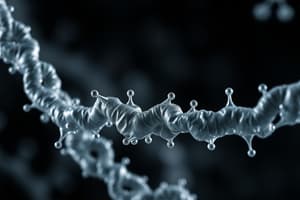Podcast
Questions and Answers
What is the main function of lipids in living organisms?
What is the main function of lipids in living organisms?
- Serve as energy sources
- Facilitate metabolic processes
- Carry genetic information
- Act as structural components (correct)
Which biomolecule is composed of carbon, hydrogen, and sometimes oxygen atoms?
Which biomolecule is composed of carbon, hydrogen, and sometimes oxygen atoms?
- Carbohydrates
- Lipids (correct)
- Nucleic acids
- Proteins
What type of molecules form cell membranes due to their amphiphilic nature?
What type of molecules form cell membranes due to their amphiphilic nature?
- Carbohydrates
- Proteins
- Nucleic acids
- Lipids (correct)
Which biomolecule consists of chains of monosaccharides?
Which biomolecule consists of chains of monosaccharides?
What is the role of nucleic acids in controlling cell growth and division?
What is the role of nucleic acids in controlling cell growth and division?
What is one way visually impaired individuals can interact with scientific databases?
What is one way visually impaired individuals can interact with scientific databases?
How do glycan modifications impact the biology of living things?
How do glycan modifications impact the biology of living things?
Which technique allows researchers to analyze interactions between biomolecules in real-time?
Which technique allows researchers to analyze interactions between biomolecules in real-time?
Why is understanding the structure and properties of biomolecules essential for various fields?
Why is understanding the structure and properties of biomolecules essential for various fields?
What role do advanced imaging techniques play in biomedical research?
What role do advanced imaging techniques play in biomedical research?
Flashcards are hidden until you start studying
Study Notes
Biomolecules
Biomolecules are organic molecules that play crucial roles in living organisms. They can be classified into four main categories: carbohydrates, lipids, proteins, and nucleic acids. Carbohydrates serve as energy sources and storage materials, while lipids act as structural components and insulators within cell membranes. Proteins facilitate various metabolic processes and maintain the integrity of cells, and nucleic acids carry genetic information and control cell growth and division.
Carbohydrates consist of carbon atoms bonded with hydrogen and oxygen atoms. Monosaccharides, like glucose, are simple sugars, whereas polysaccharides, such as starch and glycogen, are chains of monosaccharides. Lipids, including fatty acids and phospholipids, are composed of carbon, hydrogen, and sometimes oxygen atoms. Phospholipids, in particular, are amphiphilic molecules that form cell membranes due to their polar head groups and nonpolar tails. Proteins are large macromolecules built from multiple amino acids linked by peptide bonds. Nucleic acids include deoxyribonucleic acid (DNA) and ribonucleic acid (RNA), both of which contain nitrogen bases, pentose sugars, and phosphate groups.
In recent years, advances in biotechnology have enabled the discovery of new classes of biomolecules. For example, Stanford researchers have identified a new type of biomolecule, glycoRNA, which consists of RNA attached to sugar molecules called glycans. This discovery suggests that glycan modifications may play a significant role in the biology of all living things, potentially influencing conditions like autoimmune diseases.
Biomedical research often uses advanced imaging techniques to study biomolecules at high resolutions. For visually impaired individuals, specialized assistive technologies, such as screen readers and braille displays, allow them to interact with scientific databases and publications. Tools like braille displays and tactile graphics enable these individuals to interpret scientific graphs and figures based on touch rather than sight.
Understanding the structure and properties of biomolecules is essential for numerous fields, including medicine, agriculture, and environmental science. Techniques like surface plasmon resonance (SPR) allow researchers to analyze the interactions between biomolecules in real-time, helping to advance knowledge about the mechanisms underlying biological processes and aid in the development of diagnostic tests and therapies.
Studying That Suits You
Use AI to generate personalized quizzes and flashcards to suit your learning preferences.




